Bài giảng môn Tiếng Anh Lớp 11 - Unit 3: Becoming independent
I. Warm up:
a) Write the sense which help you now about the following things.
1.The softness of a leather briefcase
2. The fragrance of a rose
3. The color of a new shirt
4. The sound of a doorbell
5. The flavor a birthday cake
b) Read the texts and put the verbs in parentheses in the correct form.
II. Before you read:
You have attended parties several times so far. As a Vietnamese, are you sure you have had courtesy manners at a party table? Add two more Vietnamese table manners that you should observe at a party in your locality.
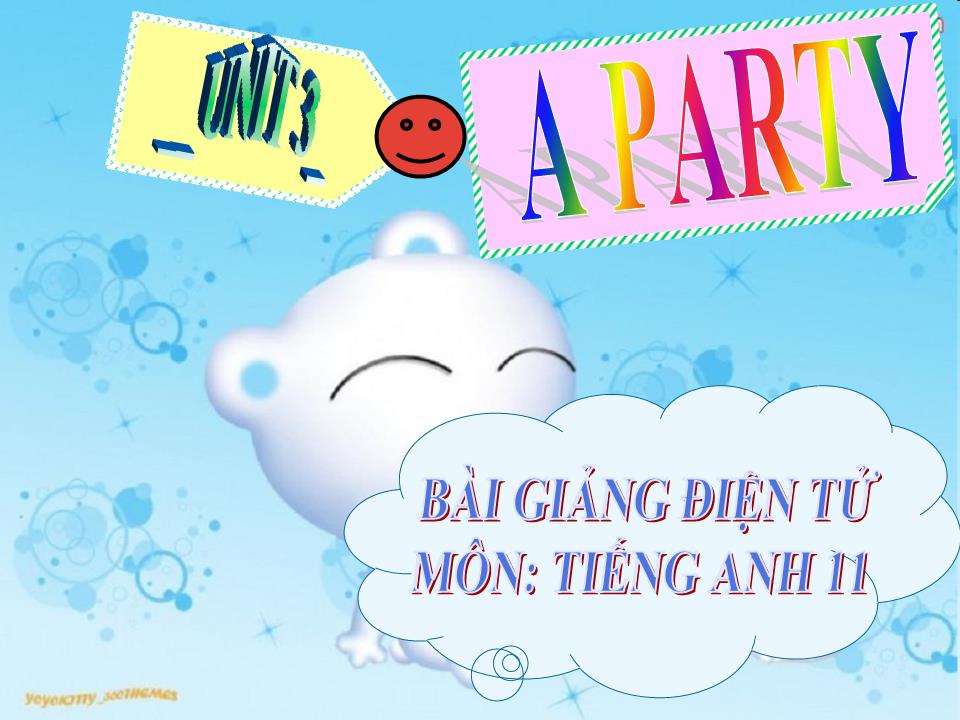
Trang 1
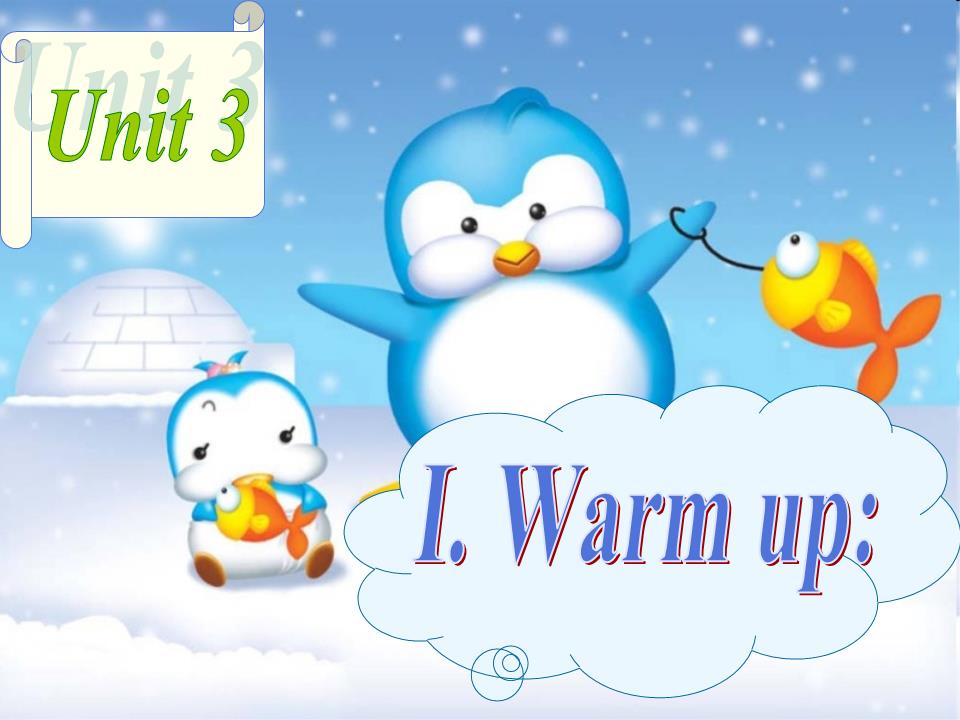
Trang 2

Trang 3

Trang 4
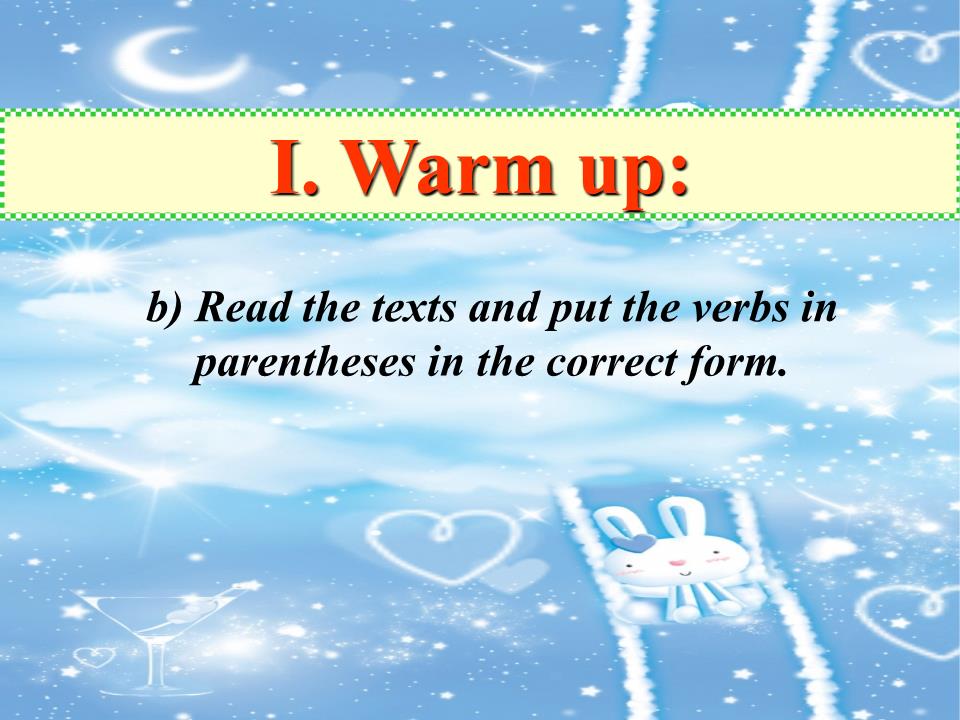
Trang 5
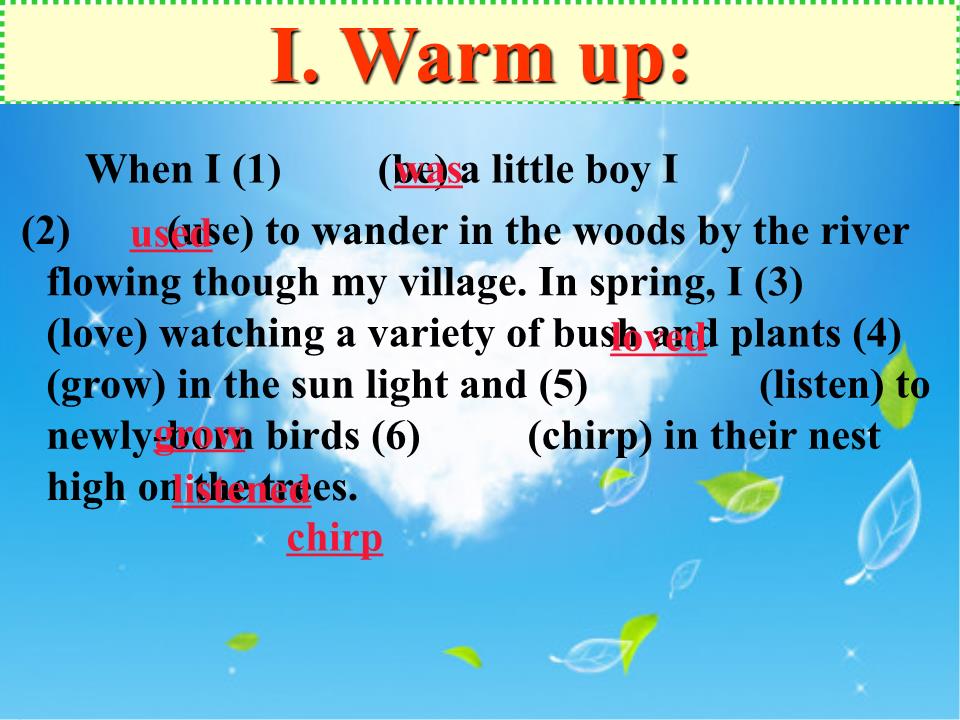
Trang 6
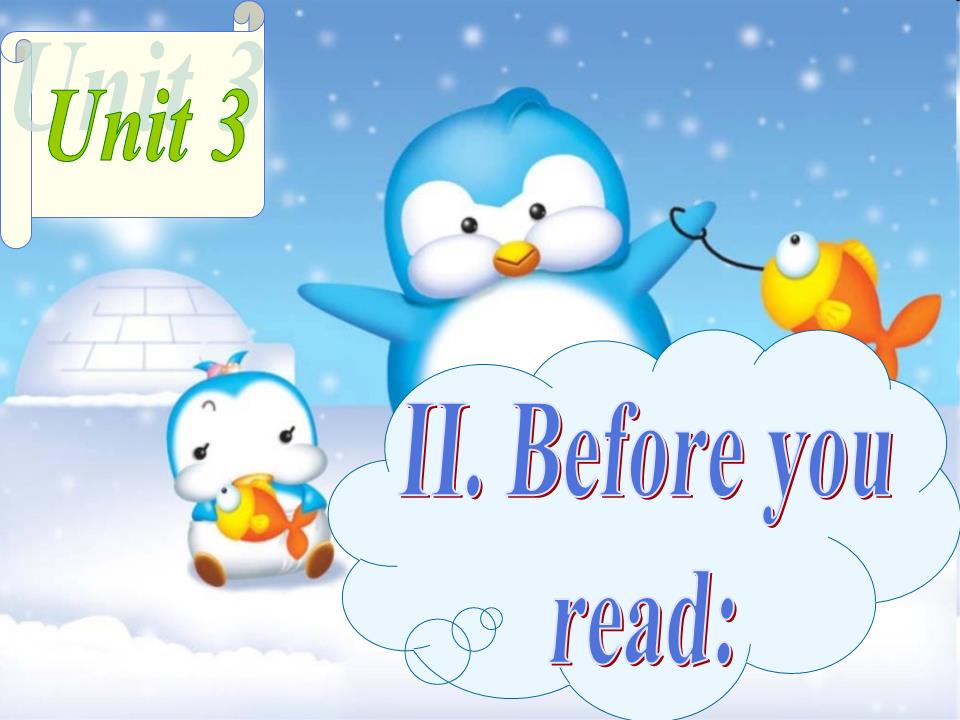
Trang 7
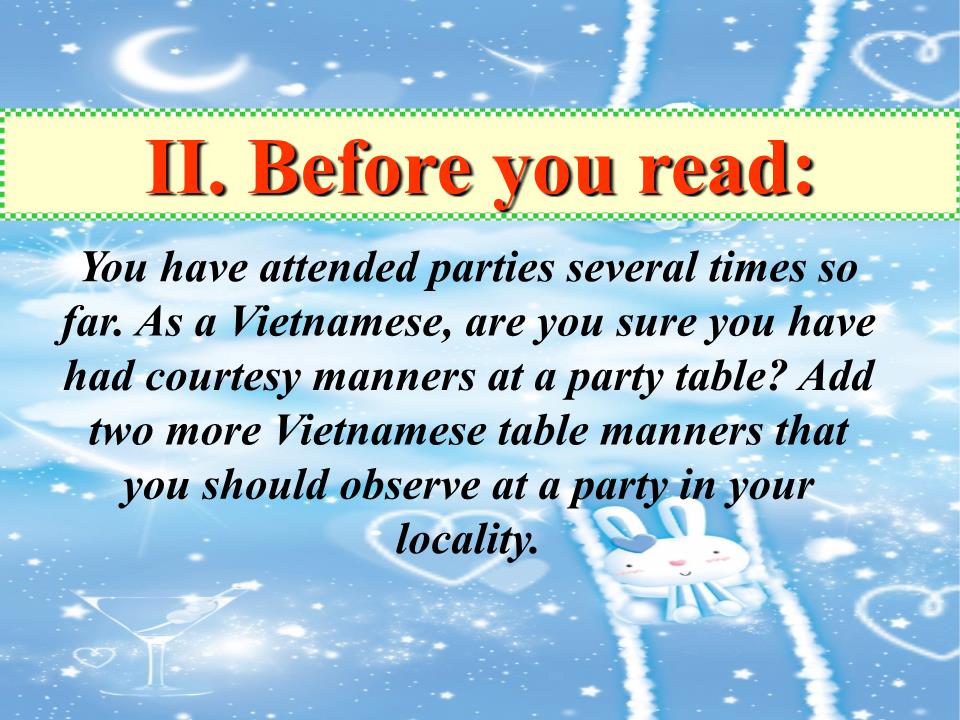
Trang 8
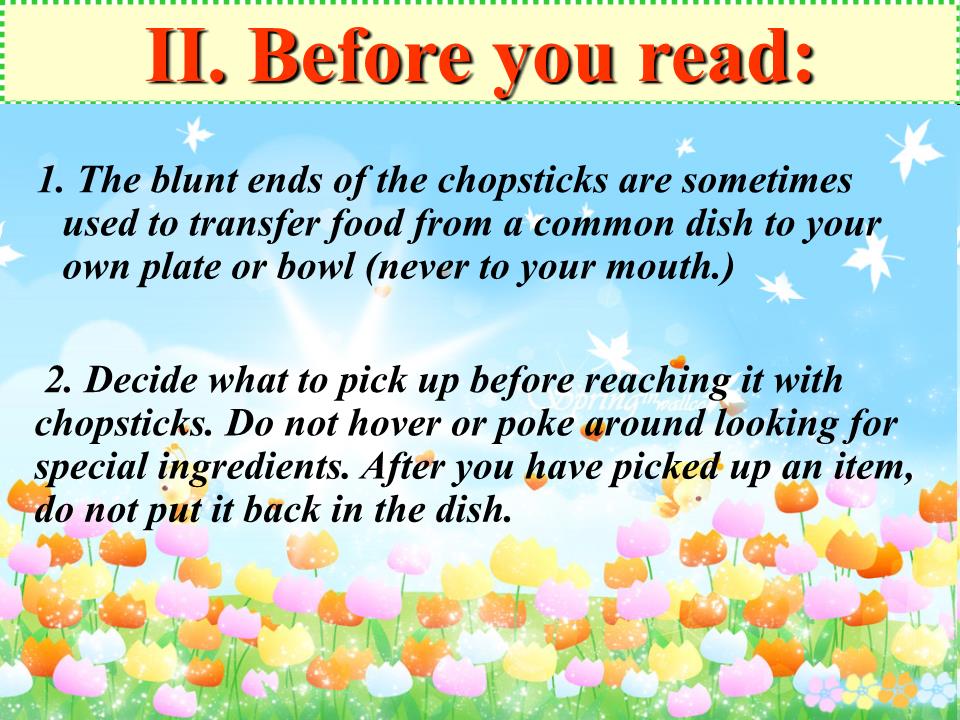
Trang 9
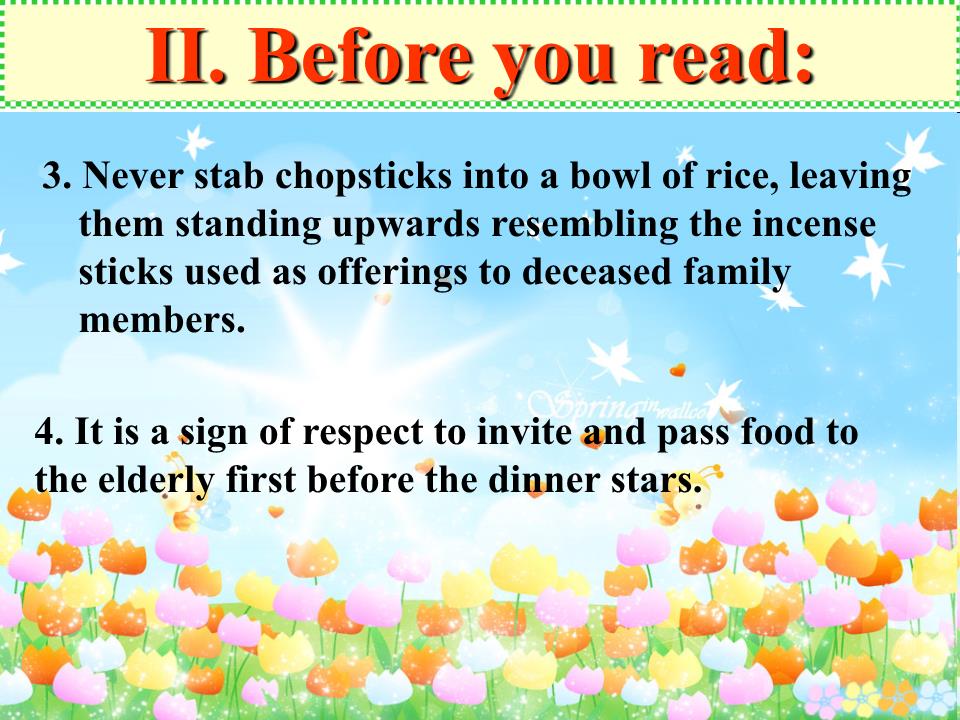
Trang 10
Tải về để xem bản đầy đủ
Bạn đang xem 10 trang mẫu của tài liệu "Bài giảng môn Tiếng Anh Lớp 11 - Unit 3: Becoming independent", để tải tài liệu gốc về máy hãy click vào nút Download ở trên
Tóm tắt nội dung tài liệu: Bài giảng môn Tiếng Anh Lớp 11 - Unit 3: Becoming independent
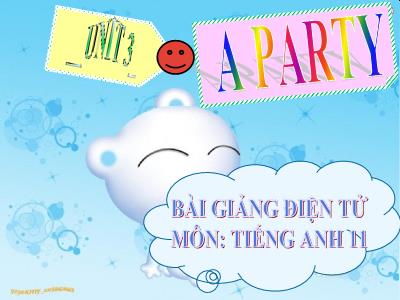
__UNIT 3_ A PARTY BÀI GIẢNG ĐIỆN TỬ MÔN: TIẾNG ANH 11 I. Warm up: I. Warm up: Unit 3 I. Warm up: a) Write the sense which help you now about the following things. I. Warm up: The softness of a leather briefcase The fragrance of a rose The color of a new shirt The sound of a doorbell The flavor a birthday cake Senses Touch Smell Sight Hearing Taste I. Warm up: b) Read the texts and put the verbs in parentheses in the correct form. I. Warm up: When I (1) (be) a little boy I (2) (use) to wander in the woods by the river flowing though my village. In spring, I (3) (love) watching a variety of bush and plants (4) (grow) in the sun light and (5) (listen) to newly-born birds (6) (chirp) in their nest high on the trees. was used loved grow listened chirp Unit 3 II. Before you read: You have attended parties several times so far. As a Vietnamese, are you sure you have had courtesy manners at a party table? Add two more Vietnamese table manners that you should observe at a party in your locality. II. Before you read: II. Before you read: 1. The blunt ends of the chopsticks are sometimes used to transfer food from a common dish to your own plate or bowl (never to your mouth.) 2. Decide what to pick up before reaching it with chopsticks. Do not hover or poke around looking for special ingredients. After you have picked up an item, do not put it back in the dish. II. Before you read: 3. Never stab chopsticks into a bowl of rice, leaving them standing upwards resembling the incense sticks used as offerings to deceased family members. 4. It is a sign of respect to invite and pass food to the elderly first before the dinner stars. Unit 3 III. While you read: III. While you read: a) Complete table with what you should observe and what you shouldn’t when attending a British-hosted party. The first one has been done for you. Do’s Don’t s 1. Chew with mouth closed Talk while chewing 2. Refrain from coughing or sneezing at the table Rest elbows on the table while there is food III. While you read: 3. Lift soup by the spoon in movements away from yourself, not toward Use fingers except in the case of bread and other similar foods 6. Cross the cutlery diagonally on the plate after cutting the food and conveying it to the mouth Tuck the napkin into the collar Do’s Don’t s 4. Put your cutlery to the side of your plate at the four and eight o’ clock position, on opposite sides of the plate, then the waiter won’t remove your plate. Prepare the next mouthful while still eating the one before III. While you read: 5. Put your cutlery in the twelve o’clock position when you have finished. Lick the knife 9. Remove the teaspoon from the cup before drinking Do’s Don’t s 7. Place your hands on your lap until the mouthful is completely finished III. While you read: 8. Use the fork to convey any solid food to the mouth b) Read the extract again. Explain what the italicized words in the following sentences refer to. III. While you read: . III. While you read: 1. As a result, they tend to reinforce cultural standards. They refers to parties. III. While you read: 2. This is especially true of table manners, a type of etiquette used when eating. A type of etiquette is a way of explaining table manners. III. While you read: 3. The following are a few basic British table manners. The following refers to the information coming after the phrase – the do’s and don’t s which follow. III. While you read: c) Find words or phrase in the extract that express meanings similar to those provided . III. While you read: 1.raised 2.protocol 3.knives, forks, scissors 4.friendly and sociable lifted etiquette cutlery congenial III. While you read: d) Work in groups. Discuss some common Vietnamese table manners you should explain to a foreign guest. * Here are some of Vietnamese Table Manners: III. While you read: III. While you read: Vietnamese dining is a social occasion. Be prepared for constant interaction. If the meal is particularly formal, you are unlikely to be allowed to serve yourself. Your host will make sure you have ample food. Only pick up one piece of food at a time. Chopsticks are not shovels. Never return a piece of food from your plate to the serving dish. III. While you read: Always place the food on your plate or in your rice bowl first; then pick it back up and eat it. It is polite to use both hands when offering something or passing some thing. The same is true for accepting something. Do NOT hunt and peck to find the “good stuff” on a serving plate. Doing so will leave your guests a low opinion of you. Unit 3 IV. After you read: III. While you read: Look at the picture and answer the name of the parties. IV. After you read: The Thanksgiving party IV. After you read: The Halloween party IV. Af
File đính kèm:
 bai_giang_mon_tieng_anh_lop_11_unit_3_becoming_independent.ppt
bai_giang_mon_tieng_anh_lop_11_unit_3_becoming_independent.ppt

